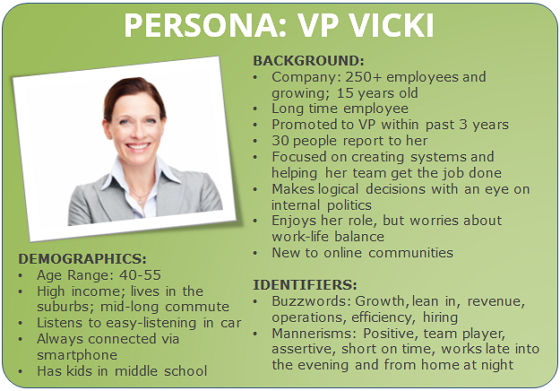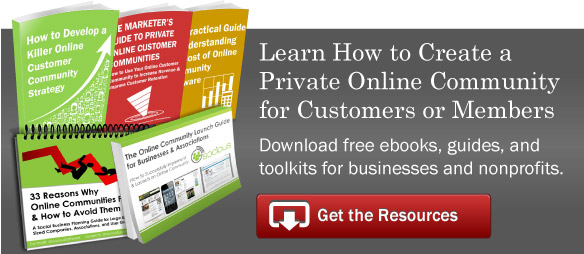How to Capitalize on One of the Most Underutilized Online Community Management Tools
You have numerous tools at your disposal for growing and managing your online customer community—from content calendars to analytics.
What if there was one tool you weren’t using that could make a substantial difference in delivering consistent engagement in your community?
Well, you’re in luck. Introducing: personas.
You might be familiar with personas through the work of your marketing department. In fact, buyer personas might have played a role in what led your private online customer community members become customers in the first place.
But the usefulness of personas doesn’t have to stop at the buying process. They can continue to play a substantial role in managing customer relationships in your online community.
The Importance of Personas in Your Online Customer Community
What are Personas?
Like in marketing, online community personas are a composite personification of your primary target audience groups.
Community managers and customer experience strategists develop personas to understand customers’ needs and motivations based on their behavior, background, and current circumstances. By gaining insight into who your customers are, what they’re trying to accomplish through their involvement in your private online community, and the forces that influence their behavior, you can better provide the type of customer experience they seek.
Obviously every member of your community is unique and different in their own way, but personas allow you to categorize characteristics that inform the decisions you make in planning and managing your private online community.
Creating personas is essentially dividing your customer base into groups of similar defining traits. For instance, let’s say you’re looking to drive engaging by adding a series of short “how-to” videos to your customer community’s video library. Wouldn’t you shape the content differently if you were trying to engage the on-the-ground technology professional in the community versus the senior executives in the community?
If you know details about a customer—such as their demographic, position in their company or stage in the engagement funnel—you can roll out content, discussions, and features that speak to their experience. When people find information that addresses their specific needs and world view, they are more likely to consume it, respond to it, and share it.
Why Do Personas Matter In Online Customer Communities?
Even though the members of your online customer community have already purchased your product or service, that doesn’t mean you should stop marketing to them.
The difference is that, rather than convincing them to purchase, you’re seeking a different kind of action: engagement in your community.
The success of your private online customer community depends on your customers giving their time, attention, and expertise. Developing personas helps ensure that your community is striking the right tone to get specific groups of community members to click through, post, and interact with other members in your community.
You shouldn’t have to be a mind reader when it comes to predicting what your customers want from their experience with your company and products. By creating effective personas to develop relevant information and properly timed messages, you can align your online customer community with solving the problems that are most important to your customers.
How Do Community Managers (And Social Business Strategists) Use Personas?
Personas are applicable to every step of the engagement funnel; it’s just a matter of taking the time to analyze your target audiences and develop personas accordingly.
While it might seem like a daunting proposition, viewing every aspect of your online community through the lenses of your personas is well worth the effort— from the login page and producing exclusive content to the discussions and events.
Take a look at the following steps of the engagement funnel to see how personas make a difference.
1#) Making Customers or Members Aware of the Community
When you’re first introducing customers to your private online community, you’ll want to take their backgrounds into account to align your community with their interests. In this early stage of the engagement funnel, potential community members will be asking themselves “what’s in it for me?” Personas help you know how to answer that question based on the specifics of each customer.
For instance, depending on their role in their company, each potential community member may find value in different types of interactions in your customer community. Marketing messages that draw people to your community can then use that piece of each persona to tailor calls-to-action toward the collective needs of specific personas.
#2) Inviting Customers or Members to Join the Community
Once an invitation has been extended, your customers will have the choice to invest their time and attention in checking out what your community has to offer or ignoring your marketing messages.
At this point, your organization is still marketing the community to your customers. Using personas in this stage of the funnel allows community managers to know which aspects of the community to emphasize to make signing up for the community the desirable action or your busy customers.
In further examining the IT vs executive example from earlier in this article, you can use personas to ensure that the messages you send to IT professionals and the ones you send to senior executives are relevant to each audience.
#3) Driving Customers or Members to Login (or visit in the case of a community with single sign-on)
It’s one thing to accept an invitation, create a profile, and explore what the community as to offer, it’s another to put it to use in your workday. Your strategy to bring community members back to the community needs to build in a certain degree of value and intrigue.
These messages are based on the insight provided by personas to entice new members to invest the time and brain-share in returning to your private online customer community. Personas built around the goals and motivations of your customers or members can tell you what would drive them toward logging into or visiting your community on a regular basis.
#4) Getting Customers or Members to Contribute
As we’ve mentioned before, your members have plenty of online distractions to fill their day, so your private online customer community has to offer them extraordinary value that captures their attention and motivates them to contribute.
To know what your value proposition for participation is, you need to deeply understand your customers’ personas. Community managers can then shape the content, conversations, and features in your private online community to steer people toward becoming an active member of the community.
#5) Motivating Customers or Members to Contribute Regularly
Once your customers decide that participating in your online community is beneficial to them, keeping their interest for the long term (in the face of growing distractions) becomes the next priority. As customers or members transition through the stages of the engagement funnel, their interests and purpose for engaging may also change.
Messages that motivate new members of the community are different than those that spur an established customer to take action. Creating and maintaining updated personas helps to ensure your private online community is still relevant to your customers needs and worth their time to participate.
#6) Turning Established Members into Leaders
By the time your customers reach the stage of engagement within your private online customer community where you are considering reaching out to them to be volunteer leaders, you will likely understand their challenges and goals pretty well. While vocal leaders in your community can be your biggest advocates in your market, they can also be your loudest detractors if you don’t respect the trust that you have built.
Use your community leader personas to ensure that your communication and decisions take into account the needs and status of your elite customers and longtime members.
Online Customer Community Personas Takeaway
Though personas do require time, effort, and maintenance, the difference they can make in your private online customer communities is well worth it. Knowing your customers’ personal and professional concerns, motivations, and goals is the best way to know what they want from your private online community.
By using personas to inform the decisions you make within your private online community, you can provide your customers or members with an experience that they value and come to rely on over time.

